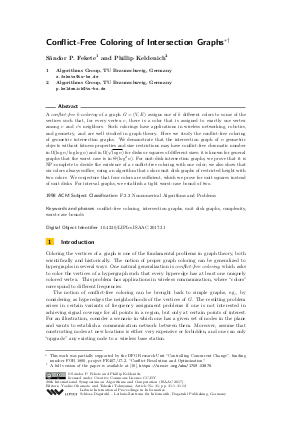Conflict-Free Coloring of Intersection Graphs
Authors Sándor P. Fekete, Phillip Keldenich
-
Part of:
Volume:
28th International Symposium on Algorithms and Computation (ISAAC 2017)
Part of: Series: Leibniz International Proceedings in Informatics (LIPIcs)
Part of: Conference: International Symposium on Algorithms and Computation (ISAAC) - License:
 Creative Commons Attribution 3.0 Unported license
Creative Commons Attribution 3.0 Unported license
- Publication Date: 2017-12-07
File

PDF
LIPIcs.ISAAC.2017.31.pdf
- Filesize: 0.7 MB
- 12 pages
Document Identifiers
Subject Classification
Keywords
- conflict-free coloring
- intersection graphs
- unit disk graphs
- complexity
- worst-case bounds
Metrics
- Access Statistics
-
Total Accesses (updated on a weekly basis)
0PDF Downloads0Metadata Views
Abstract
A conflict-free k-coloring of a graph G=(V,E) assigns one of k different colors to some of the vertices such that,
for every vertex v, there is a color that is assigned to exactly one vertex among v and v's neighbors.
Such colorings have applications in wireless networking, robotics, and geometry, and are well studied in graph theory.
Here we study the conflict-free coloring of geometric intersection graphs.
We demonstrate that the intersection graph of n geometric objects without fatness properties and size restrictions may have conflict-free chromatic number in \Omega(log n/log log n) and in \Omega(\sqrt{\log n}) for disks or squares of different sizes;
it is known for general graphs that the worst case is in \Theta(log^2 n).
For unit-disk intersection graphs, we prove that it is NP-complete
to decide the existence of a conflict-free coloring
with one color; we also show that six colors always suffice,
using an algorithm that colors unit disk graphs of restricted height with two colors.
We conjecture that four colors are sufficient, which we prove for unit squares instead of unit disks.
For interval graphs, we establish a tight worst-case bound of two.
Cite As Get BibTex
Sándor P. Fekete and Phillip Keldenich. Conflict-Free Coloring of Intersection Graphs. In 28th International Symposium on Algorithms and Computation (ISAAC 2017). Leibniz International Proceedings in Informatics (LIPIcs), Volume 92, pp. 31:1-31:12, Schloss Dagstuhl – Leibniz-Zentrum für Informatik (2017)
https://doi.org/10.4230/LIPIcs.ISAAC.2017.31
BibTex
@InProceedings{fekete_et_al:LIPIcs.ISAAC.2017.31,
author = {Fekete, S\'{a}ndor P. and Keldenich, Phillip},
title = {{Conflict-Free Coloring of Intersection Graphs}},
booktitle = {28th International Symposium on Algorithms and Computation (ISAAC 2017)},
pages = {31:1--31:12},
series = {Leibniz International Proceedings in Informatics (LIPIcs)},
ISBN = {978-3-95977-054-5},
ISSN = {1868-8969},
year = {2017},
volume = {92},
editor = {Okamoto, Yoshio and Tokuyama, Takeshi},
publisher = {Schloss Dagstuhl -- Leibniz-Zentrum f{\"u}r Informatik},
address = {Dagstuhl, Germany},
URL = {https://drops.dagstuhl.de/entities/document/10.4230/LIPIcs.ISAAC.2017.31},
URN = {urn:nbn:de:0030-drops-82162},
doi = {10.4230/LIPIcs.ISAAC.2017.31},
annote = {Keywords: conflict-free coloring, intersection graphs, unit disk graphs, complexity, worst-case bounds}
}
Author Details
References
-
Mohammad Ali Abam, Mark de Berg, and Sheung-Hung Poon. Fault-tolerant conflict-free colorings. In Proc. 20th Canadian Conference on Computational Geometry (CCCG), pages 13-16, 2008.

-
Zachary Abel, Victor Alvarez, Erik D. Demaine, Sándor P. Fekete, Aman Gour, Adam Hesterberg, Phillip Keldenich, and Christian Scheffer. Three colors suffice: Conflict-free coloring of planar graphs. In Proc. 28th Symp. Discrete Algorithms, pages 1951-1963, 2017.

-
Deepak Ajwani, Khaled Elbassioni, Sathish Govindarajan, and Saurabh Ray. Conflict-free coloring for rectangle ranges using O(n^.382) colors. In Proc. 19th ACM Symposium on Parallelism in Algorithms and Architectures (SPAA), pages 181-187, 2007.

-
Noga Alon and Shakhar Smorodinsky. Conflict-free colorings of shallow discs. In Proc. 22nd Symposium on Computational Geometry (SoCG), pages 41-43, 2006.

-
Andreas Bärtschi, Subir Kumar Ghosh, Matúš Mihalák, Thomas Tschager, and Peter Widmayer. Improved bounds for the conflict-free chromatic art gallery problem. In Proc. 30th Symposium on Computational Geometry (SoCG), pages 144-153, 2014.

-
Panagiotis Cheilaris, Luisa Gargano, Adele A. Rescigno, and Shakhar Smorodinsky. Strong conflict-free coloring for intervals. Algorithmica, 70(4):732-749, 2014.

-
Khaled Elbassioni and Nabil H. Mustafa. Conflict-free colorings of rectangles ranges. In 23rd Proc. Symposium on Theoretical Aspects of Computer Science (STACS), pages 254-263, 2006.

-
Guy Even, Zvi Lotker, Dana Ron, and Shakhar Smorodinsky. Conflict-free colorings of simple geometric regions with applications to frequency assignment in cellular networks. SIAM Journal on Computing, 33(1):94-136, 2003.

-
Sándor P. Fekete, Stephan Friedrichs, Michael Hemmer, Joseph B. M. Mitchell, and Christiane Schmidt. On the chromatic art gallery problem. In Proc. 26th Canadian Conference on Computational Geometry (CCCG), pages 1-6, paper 11, 2014.

-
Sándor P. Fekete and Phillip Keldenich. Conflict-free coloring of intersection graphs. arXiv preprint arXiv:1709.03876, 2017.

-
Luisa Gargano and Adele A. Rescigno. Complexity of conflict-free colorings of graphs. Theoretical Computer Science, 566:39-49, 2015.

-
Roman Glebov, Tibor Szabó, and Gábor Tardos. Conflict-free coloring of graphs. Combinatorics, Probability and Computing, 23:434-448, 2014.

-
Sariel Har-Peled and Shakhar Smorodinsky. Conflict-free coloring of points and simple regions in the plane. Discrete & Computational Geometry, 34(1):47-70, 2005.

-
Frank Hoffmann, Klaus Kriegel, Subhash Suri, Kevin Verbeek, and Max Willert. Tight bounds for conflict-free chromatic guarding of orthogonal art galleries. In Proc. 31st Symposium on Computational Geometry (SoCG), pages 421-435, 2015.

-
Elad Horev, Roi Krakovski, and Shakhar Smorodinsky. Conflict-free coloring made stronger. In Proc. 12th Scandinavian Symposium and Workshops on Algorithm Theory (SWAT), pages 105-117, 2010.

-
Ross J. Kang and Tobias Müller. Sphere and dot product representations of graphs. Discrete & Computational Geometry, 47(3):548-568, 2012.

-
Chaya Keller and Shakhar Smorodinsky. Conflict-free coloring of intersection graphs of geometric objects. arXiv preprint arXiv:1704.02018, 2017.

-
Nissan Lev-Tov and David Peleg. Conflict-free coloring of unit disks. Discrete Applied Mathematics, 157(7):1521-1532, 2009.

-
Colin McDiarmid, Dieter Mitsche, and Pawel Pralat. Clique colourings of geometric graphs. arXiv preprint arXiv:1701.02693, 2017.

-
Wolfgang Mulzer and Günter Rote. Minimum-weight triangulation is NP-hard. Journal of the ACM, 55(2):11, 2008.

-
János Pach and Gábor Tardos. Conflict-free colourings of graphs and hypergraphs. Combinatorics, Probability and Computing, 18(05):819-834, September 2009.

-
Shakhar Smorodinsky. Combinatorial Problems in Computational Geometry. PhD thesis, School of Computer Science, Tel-Aviv University, 2003.

